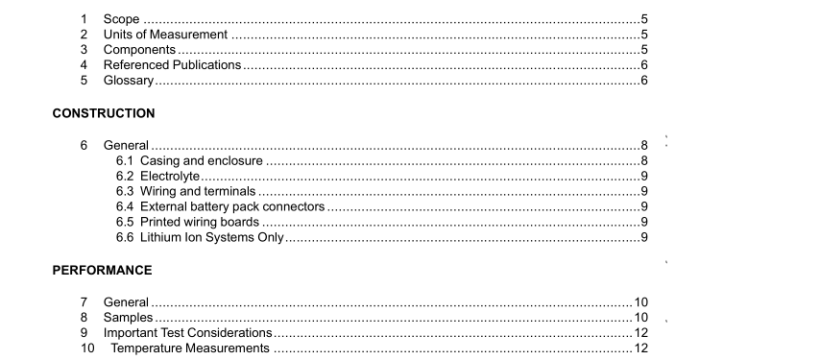UL 2054-2021 pdf download.Household and Commercial Batteries.
4 Referenced Publications 4.1 Any undated reference to a code or standard appearing in the requirements of this Standard shall be interpreted as referring to the latest edition of that code or standard. 4.2 The following publications are referenced in this Standard: UL 248-14, Low-Voltage Fuses – Part 14, Supplemental Fuses UL 746C, Polymeric Materials – Use in Electrical Equipment Evaluations UL 796, Printed-Wiring Boards UL 969, Marking and Labeling Systems UL 1434, Thermistor-Type Devices UL 1642, Lithium Batteries UL 60691, Thermal-Links – Requirements and Application Guide UL 60730-1, Automatic Electrical Controls – Part 1: General Requirements 5 Glossary 5.1 For the purpose of these requirements the following definitions apply. 5.2 BATTERY – General term for (1) any single cell, or (2) a group of cells connected together either in a series and/or parallel configuration. May be ready for use or may be an installed component. NOTE: The term “battery(ies)” refers to single or multicell batteries. 5.3 BATTERY PACK – A battery which is ready for use, contained in a supplemental rigid enclosure, with or without protective devices. 5.4 BATTERY, PRIMARY – A battery that can only be discharged once. It is not designed to be electrically recharged and must be protected from a charging current. 5.5 BATTERY, SECONDARY – A battery that is intended to be discharged and recharged many times in accordance with the manufacturer’s recommendations. 5.6 C 5 AMP RATE – The current, in amperes, that a cell or battery can be discharged at for 5 h to the voltage cutoff point specified by the manufacturer.
5.9 CELL, COMPONENT – The basic functional electrochemical unit containing an assembly of electrodes, electrolyte, container, terminals, and usually separators, that is a source of electrical energy by direct conversion of chemical energy. May be ready for use or may be provided as component of battery pack. 5.10 CELL OPERATING REGION (lithium ion systems) – The range of voltage, current, and temperature in which the cell operates during charging or discharging as specified by the cell manufacturer. 5.11 COMPONENT, CURRENT-LIMITING – Any component employed to limit current during abnormal conditions. Current-limiting components include resistors, fuses, or PTC thermistor type devices. 5.12 COMPONENT, TEMPERATURE-LIMITING – Any component used to limit temperature during abnormal conditions. Temperature-Limiting Components include thermal protectors and thermal cutoffs. 5.13 CURRENT, ABNORMAL CHARGING – Also called overcharge current for secondary cells; maximum rated charging current to a cell or battery under fault condition. 5.14 DISCHARGE, FORCED – Subsequent discharge of one fully discharged cell in each parallel string by connecting in series with fresh cells of the same kind so as to drive the cell into polarity reversal. 5.15 DISCHARGED, FULLY – A condition of battery energy potential representing depletion of 100 % of its rated capacity (for primary cell or battery) or depletion to its end-point-voltage as specified by the manufacturer (for a secondary cell or battery). 5.16 ENCLOSURE – The outer housing of a battery pack that provides mechanical protection and a level of fire protection for internal cells and components of the battery pack. 5.17 EXPLOSION – A condition that occurs when a cell container or battery case violently opens and major components are forcibly expelled. 5.18 MAXIMUM CHARGING CURRENT AT SPECIFIED TEMPERATURES (lithium ion systems) – The maximum charging current at specified temperatures in the cell operating region, which is specified by the cell manufacturer.
6 General 6.1 Casing and enclosure 6.1.1 The casing of a cell or single cell battery, or the enclosure of a battery pack shall have the strength and rigidity required to resist the possible abuses, that it is exposed to during its intended use, in order to reduce the risk of fire or injury to persons. 6.1.2 The casing of a cell, or single cell battery, or the enclosure of a battery pack shall be rigid enough to prevent flexing that would result in damage to the cells or internal protective components. A tool providing the mechanical advantage of a pliers, hacksaw, or similar tool, shall be the minimum mechanical capability required to open the cell casing or battery pack enclosure. Exception No. 1: This requirement does not apply to a cell or a single cell battery containing electrodes with less than 0.04 g (0.0014 oz) ofactive mass. This requirements does not apply to a lithium ion polymer orlithium polymercell (i.e. pouch type cells) ofa battery pack, which rely upon the battery pack enclosure orend use application formechanical protection. Exception No. 2: This requirement does not apply to incomplete battery packs that rely upon the end use application formechanical protection.UL 2054-2021 pdf download.
UL 2054-2021 pdf download
